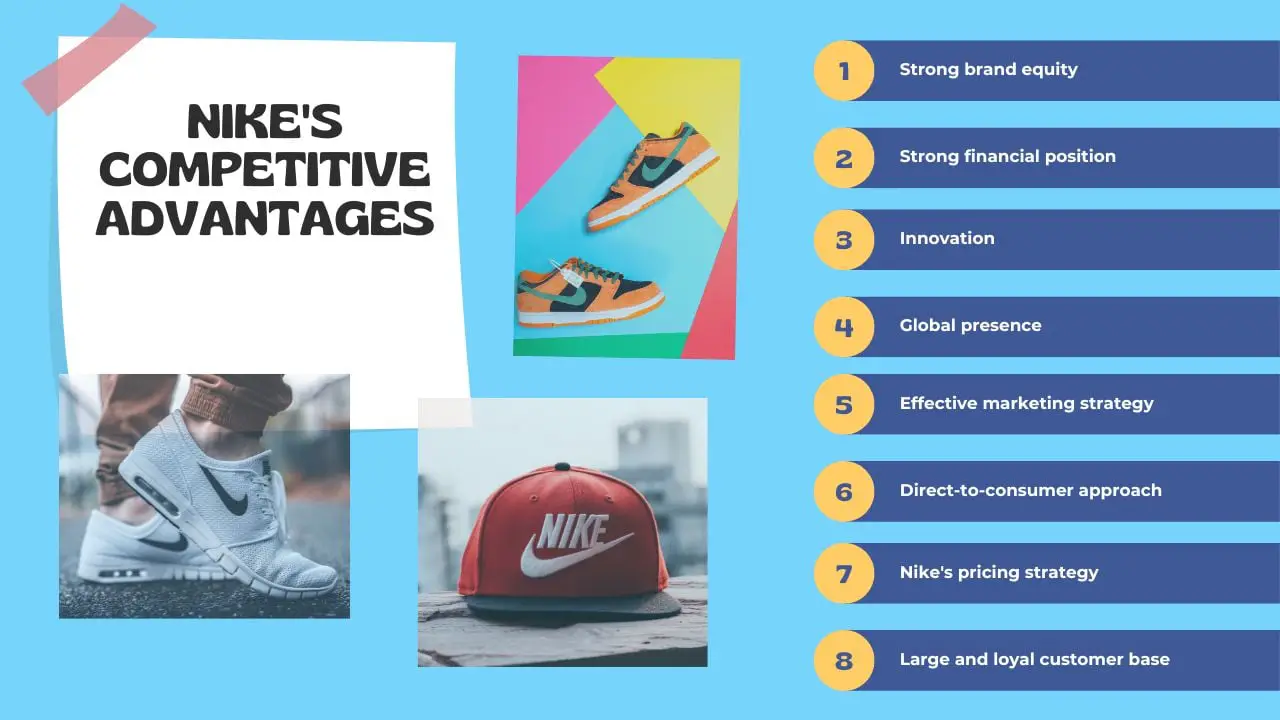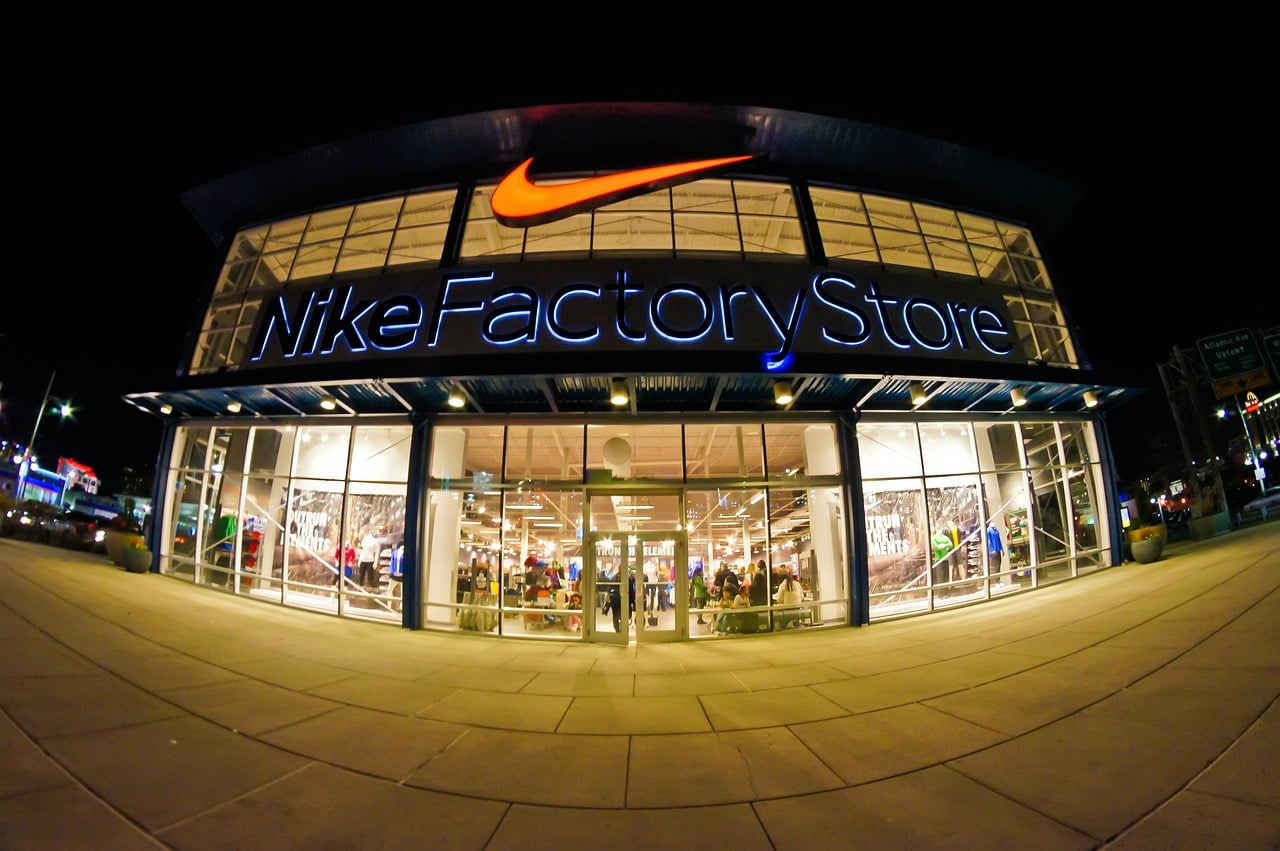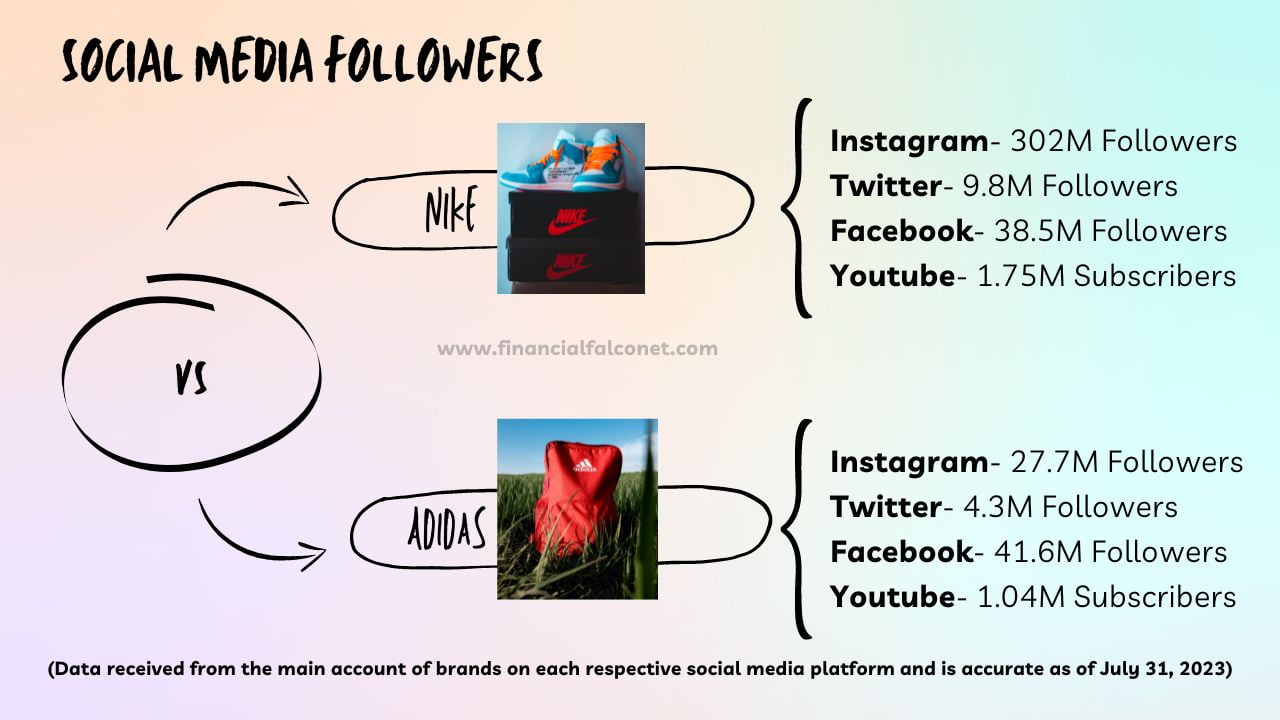Nike was founded in 1964 by Phil Knight and Bill Bowerman and has since then grown to be one of the most popular brands in the world. Due to Nike’s competitive advantage, the company has a long history of success and profit margins.
The success of this world-renowned sports, footwear, and apparel company over its competitors could be attributed to its high level of innovation, quality, loyal customer base, and many other factors.

Nike and many other companies use different strategies to gain a competitive advantage and improve their competitive position in their industry. We will see how Nike’s competitive advantages have helped the company and the strategies it employs to stay competitive in its industry.
Check out: McDonald’s Competitive Advantage
Nike’s competitive strategies
- Differentiation leadership strategy
- Differentiation focus strategy
- Cost leadership strategy
According to Porter’s generic strategies, a company gains competitive advantage in four different ways- cost leadership strategy, differentiation leadership strategy, differentiation focus strategy, and cost focus strategy.
Due to the state of the athletic footwear and apparel industry as well as the diversity of regional markets, Nike combines three generic strategies (as listed above) to gain a competitive advantage over its competitors.
Differentiation leadership strategy
The differentiation leadership strategy is a type of competitive strategy that involves emphasizing the uniqueness of your brand to gain a competitive advantage in a saturated market. This is the primary competitive strategy that Nike uses; it develops products that possess unique qualities in order to differentiate them from other competitors.
Nike’s competitive strategy capitalizes on the exclusivity or uniqueness of the company’s product while targeting the entire market. That is, the company focuses on making unique sporting items and apparel for the general population. For instance, Nike makes trendy and sporty sneakers that appeal to celebrities and sports professionals, while still catering to the needs of average customers.
The company has a reputation for using cutting-edge materials and design techniques to produce products that are both high-performing and stylish. This generic strategy, has, therefore, built up Nike’s competitive advantages and has contributed to the company’s intensive growth.
Differentiation focus strategy

Another type of competitive strategy that Nike uses in its operation is a differentiation focus strategy. This strategy is similar to the differentiation leadership strategy, only that when using differentiation focus, Nike targets buyers in a segment of the market.
That is, this Nike’s competitive strategy involves the company creating sports-specific or activity-specific products. This strategy influences product development, as a way to enhance the company products’ competitive advantages.
For instance, Nike has shoes that are specially designed for football and soccer; made with studs that are not suitable for use on the streets. Such a strategy enhances Nike’s competitive advantage because the brand becomes associated with athletic use and is easily preferred over other brands when it comes to sports.
Cost leadership strategy
A cost leadership strategy is another strategy used by companies like Nike to stay competitive. This involves lowering the costs of production to offer quality products at low prices. This strategy is more effective for large companies with lots of buying power than for small businesses.
Nike uses cost leadership by outsourcing to low-cost contract manufacturers, like those located in Asia. This approach tends to strategically minimize the company’s production costs while maximizing its profit margins. Therefore, this strategy, together with the relatively high selling prices of the company’s products, increases the profitability of the business which is a competitive advantage for Nike.
See also: Tesla Competitive Advantage and Strategy
What is Nike’s competitive advantage?
Nike’s competitive advantages include a strong focus on innovation, a strong brand presence, effective marketing strategies, high-quality products, a strong financial position, a direct-to-consumer approach, an effective pricing strategy, and a loyal customer base.
Nike, as a company is taking a lot of actions to give it an edge over its competitors. Its competitive advantage is based on addressing recent fashion trends in the area of sports apparel and footwear by using cutting-edge technology to provide high-quality products to consumers.
Another prominent competitive advantage of Nike is its strong brand equity and its flexibility and adaptability to customers’ demands and differences in the market. This has given the company a loyal customer base that competitors are finding hard to match up with.
Read about: Netflix’s Vertical Integration Strategy and Examples
Nike’s Competitive Advantages
- Strong brand equity
- Innovation
- Strong financial position
- Diverse product portfolio
- Global presence
- Large and loyal customer base
- A strong relationship with suppliers
- Effective marketing strategy
- Direct-to-consumer approach
- Nike’s pricing strategy
Strong brand equity

Nike is one of the most recognized brands across the globe. Over the years, the company has managed to build up a strong reputation for innovation and quality.
The company’s strong brand equity has attracted a large number of loyal customers and this has been a competitive advantage for Nike because these customers are more than willing to pay a premium for the company’s products. This results in more revenue generation for the company, giving it an edge over its competitors.
For example, Nike had an annual revenue of $46.71 Billion in 2022, which was a 4.88% increase from 2021, compared to one of its competitors, Adidas AG, which had an annual revenue of $23.718 Billion in 2022, which was a 5.59% decline from 2021. This obvious difference in sales is a typical example of how Nike’s strong brand equity gives it a competitive advantage over its competitors.
Innovation
Innovation is a very prominent competitive advantage of Nike. The company has a strong focus on innovation and this has given it a competitive position in its industry. It is one thing to have customers and it is another thing to retain them.
Nike’s speed of iteration and innovations keeps its customers engaged and loyal. The company always comes up with new and innovative products and constantly looks for ways to improve its products to stay ahead of the competition.
Being in a better financial position, Nike has been able to invest heavily in research and development over the years. This has helped the brand produce some of the most innovative products in the market.
Also, the brand’s use of cutting-edge technology for its innovations usually gives its product a significant advantage over other brands. Typical examples include the ‘Nike By You’ online initiative, Dri-FIT technology, and Nike Forward.
The manufacturing process of Nike Forward, for instance, makes far-reaching changes in apparel creation by turning fiber directly into textiles through needle punch. The development of this significant apparel innovation took more than five years of research.
The Nike Forward is different because it is not a traditional knit or woven material. It is a completely new material that drastically reduces carbon footprint compared to traditional knit fleece.
This innovation (shifting from traditional knit and woven processes) reduces the steps involved in the process of material fabrication. The reduction in multiple steps results in less energy consumption, thus contributing to an average of 75% carbon reduction compared to traditional knit fleece.
Compared to traditional knit fleece, Nike Forward material has a lighter density and its finished product is made up of 70% recycled content by weight. Thus, creating a premium, sustainability-minded product that addresses the issue of climate change, which is a huge barrier to sports.
Strong financial position
Nike is financially strong, with a revenue of $37,403B, $46,710B, and $51,217B for the fiscal years 2021, 2022, and 2023 respectively. It is evident that the company’s revenue keeps growing exponentially over the years and this is no doubt one of the competitive advantages of Nike.
Due to the company’s strong financial position, Nike has a large cash reserve to be able to invest in new products and take advantage of profitable opportunities that may arise. It also has enough free cash flow to enter new markets and invest in marketing campaigns to reach a larger audience better than its competitors.
Diverse product portfolio
One of Nike’s competitive advantages is its diverse product portfolio. The company sells and offers a wide range of products, such as apparel, footwear, sports equipment, and accessories.
It also owns several successful side brands such as Hurley, Umbro, Jordan, and Converse, thus, dominating the market and gaining a larger market share than its competitors.
Nike’s diversified product line helps to protect it from fluctuations that may arise in any particular market. That is, if the sales of one line of product decelerate, the company can make up for it with increased sales of another product.
This diversification strategy gives Nike a competitive advantage because it targets a large number of potential customers due to its diversified product line.
Global presence

Another Nike competitive advantage is its global presence. This company has a strong presence in several countries across the globe. The company is headquartered in Beaverton, Oregon, but globally supplies the Apparel Accessories and Sports equipment industry, through about 1,046 retail stores (more than 300 US stores and over 700 non-US stores), as of 2022.
Apart from its retail stores, Nike also has large E-commerce platforms and wholesale ventures that contribute to its sales volume and large market presence and holdings. Such global presence is key to Nike’s competitive advantage because it gives the company a larger potential customer base to sell its products.
Large and loyal customer base
One of the competitive advantages of Nike is its large customer base. The company has built up a large customer base of loyal, dedicated, and passionate individuals. This loyalty to the brand has been earned through years of producing high-quality products and meeting up to customers’ expectations.
A strong relationship with suppliers
Another prominent Nike competitive advantage is its strong relationship with its suppliers. Over the years, the company has built strong relationships with its suppliers which has given it an advantage in terms of availability of materials and cost.
Nike’s supply chain management team has been very effective at managing the relationships with its suppliers to ensure that the best materials are available at the best prices for the company. Through these relationships, Nike is able to keep its cost structure low and its revenue high. Thus, maintaining an ever greater margin on each product that the company sells.
Nike’s strong relationship with its suppliers has been helpful, especially in terms of cost control. If the company doesn’t keep a close eye on its costs, any increase in its expenses could eat into its profit margins.
Therefore, one major issue with the company’s supply chain is its dependence on suppliers. If Nike’s suppliers were to decrease the quality of their material or raise prices, the company would have no option but to accept lower margins or pass the costs on to consumers.
Effective marketing strategy
Nike has an effective and creative product marketing strategy. It invests so much in various marketing strategies and campaigns. The company makes use of social media, celebrity endorsements, and innovative advertising campaigns to create brand awareness and drive sales.
This is a competitive advantage for Nike because it has helped the company achieve a high level of brand awareness. The company’s creative and effective marketing strategy has made it highly competitive and different from its competitors.
What are the key marketing strategies employed by Nike to gain a competitive advantage?
- Storytelling and emotional branding
- Innovative product technology
- Extensive global distribution channels
- Endorsements and sponsorships
- Effective use of the traditional medium for advertisement
- Digital Marketing
- Experiential Marketing
- Cause marketing
- Use of limited editions and collaborative collections
- Athlete Development Programs
- Personalization and Customization
- Loyalty Programs
- Event marketing
- Memorable Advertising
Storytelling and emotional branding
One of the key marketing strategies employed by Nike to gain a competitive advantage is storytelling and emotional branding. The company is known for creating appealing marketing campaigns that evoke emotional connections with its audience. Highly regarded celebrities and athletes are used to share powerful stories and testimonies of overcoming adversity that are relatable to the average consumer.
Endorsements and sponsorships
Endorsements and sponsorships are also key marketing strategies employed by Nike to gain a competitive advantage. Over the years, the company has partnered with world-famous athletes like Michael Jordan, Tiger Woods, Cristiano Ronaldo, and LeBron James to increase its brand recognition and showcase its products.
The company has a long history of endorsing and featuring prominent celebrities from music, sports, and entertainment, in their ad campaigns to facilitate an aspirational image and attract fan bases. This has helped to give Nike a competitive advantage over its competitors.
Digital Marketing
Nike’s digital marketing strategy has been very beneficial to the business. The company uses various forms of digital marketing such as social media marketing, content marketing, E-commerce optimization, etc.
As one of its social media marketing strategies, the company uses various social media platforms to create a strong online presence for its brand. It engages with its audience and gives insights into its brand. The company utilizes influencers to promote the company’s products on various social media platforms.
The company also uses a content marketing strategy to enhance Nike’s competitive advantage over its competitors. This involves creating inspiring content and engaging storytelling about athletes’ journeys and achievements to inspire customers and drive sales. Its curated content is disseminated to the audience through videos, blogs, and other media.
Nike also invests in its online presence by optimizing its mobile applications and website to offer personalization, a seamless shopping experience, and customer support to consumers. This makes Nike different from its competitors.
Experiential Marketing
Nike also uses experiential marketing to gain a competitive advantage. The company has developed unique retail experiences for its customers, such as the Nike Community Store and NikeTown stores which involve community involvement and shopping with athletics.
Cause Marketing
As one of its marketing strategies, Nike aligns its brand with various social causes such as women’s rights, equality, and environmental sustainability. This makes customers feel good about supporting and patronizing the brand.
For instance, Nike’s support for black communities has endeared it to many customers. The Black Community Commitment was launched after the murder of George Floyd, in June 2020, and the company pledged $40 million to run this program for four years. The company has been fulfilling its promise and has invested $28.9 million so far, since 2020, with national and city-specific partners through the program.
Such strategies improve the company’s customer base better than its competitors. Thus, resulting in more revenue generation for Nike.
Event Marketing
One of Nike’s competitive advantages is its use of event marketing to strengthen its brand presence. The company organizes and sponsors workout classes, sports events, marathons, and Olympic events. This, in turn, increases its brand awareness and association with sports and fitness.
Direct-to-consumer approach
The direct-to-consumer approach that was integrated into the company’s supply chain process is another competitive advantage of Nike. In 2011, Nike integrated forward by introducing Consumer Direct Acceleration. The aim of this model was to increase the company’s direct-to-consumer (DTC) sales.
This vertical integration strategy was one of Nike’s competitive advantages because it enabled the company to have better control over the customer experience and collect valuable customer data. It also enables Nike to prevent any overproduction and manage inventory levels better.
By selling more products directly to its consumer through its e-commerce site, retail stores, mobile app, and third-party retailers, Nike is able to focus on elevating its consumer experiences through more direct and personal relationships.
The company has continued to grow its DTC sales since 2011. Nike’s DTC sales grew from 16% of its revenue in 2011 to 35% of its revenue in 2020. This means the direct-to-consumer approach was more profitable and generated higher margins. Thus, giving Nike a competitive advantage over its competitors.
Nike pricing strategy
Nike has an effective pricing strategy that has enabled it to keep its prices high and still make a lot of sales. The various pricing strategies that the company use gives it a competitive advantage over its competitors.
Nike focuses on selling high-quality items at the correct price whilst most of its competitors believe that selling things at the lowest possible price would increase sales. This value-based pricing strategy that Nike uses is what determines the maximum price that customers are willing to spend on the company’s products.
For instance, a customer buys a pair of Nike shoes for $100 and sees it as a good buy because he feels the shoes are worth more than what he paid for them. This is an example of how a value-based pricing strategy is one of Nike’s competitive advantages.
This company also uses a price skimming method when producing pricey items and minimal editions. It uses this method to establish high initial costs when introducing a new design product to the market. An example of Nike using this pricing strategy to its advantage can be seen with the release of the Nike Air Max 270 shoes.
When Nike first released these shoes, they were sold at a retail price of $180. The company, then lowered the price to $150 after the initial demand for the shoes decreased. This price skimming method enabled the company to still make a profit even when the demand for the shoes decreased.
Pricing strategies that give Nike a competitive advantage
- Value-based pricing strategy: Nike determines its prices based on customer perceptions of the worth of its products.
- Premium pricing strategy: Depending on the product quality, Nike raises the prices of its product above the product price of its rivals.
- Pricing leadership strategy: Nike sets its product prices based on what its competitors are charging.
- Pricing strategy for skimming: When Nike introduces new design products to the market, it uses this strategy to establish a high initial price; thus making money from customers that desire the products and are ready to pay the price.
Related: Starbucks’ Vertical Integration Strategy
How is Nike different from its competitors?
Nike being different from its competitors revolves around its strong branding, innovation, low-cost structure, customization, global reach, and diverse product portfolio.
There are a lot of factors that make Nike different from its competitors. Nike’s branding is one major factor that makes it different from its competitors. For instance, the company’s creation of a strong image among its teenage customer base allows it to charge premium prices over its competitors. The brand is known to empower athletes and has successfully given its audience the perception that anyone who steps into Nike shoes is an athlete.
The company’s low-cost structure also gives it a competitive advantage and makes it different from its competitors. Compared to how much Nike actually sells its products, it has an extremely low cost-to-create ratio. This low-cost structure enables Nike to generate more revenue; almost twice the revenue that its closest competitor, Adidas AG, generates.
Customization is another key factor that differentiates Nike from its competitors. The company offers customer-tailored solutions. For instance, through NikeiD, customers can customize some of the products they buy, thus, making the company unique and different.
See also: Companies with Vertical Integration Strategies
What competitive advantage does Nike have over Adidas?
Even though, many of the products and services that Nike and Adidas offers are similar in terms of prices, trends, materials, etc, Nike stands out in brand recognition, quality, consumer demand, and customer base.
Nike and Adidas are both huge international companies in the apparel, footwear, and sports equipment industries, but Nike tends to have a competitive advantage over Adidas and even Puma.
For instance, in the early 1970s, Nike gained a competitive advantage over Adidas by redesigning the classic track shoe. It made the shoe more durable, comfortable, and light. By creating a shoe that lasted longer and cost less than its competitors, it was able to differentiate itself. This secured a loyal customer base for Nike as strong marketing actions were taken, and positive reviews were spread.
The involvement of sports leagues and professional athletes, as well as celebrities and influencers in campaigns, has been beneficial for both Adidas and Nike. However, Nike has arguably secured the most popular and talented athletes like Lebron James, Michael Jordan, Tiger Woods, Cristiano Ronaldo, and Kevin Durant.
In as much as these sponsorships are extremely expensive, they have been very beneficial to further the popularity of Nike’s brand over its competitors, thus increasing the consumer demand for Nike’s products.
Another competitive advantage that Nike has over Adidas is its large reach and loyal customer base. For example, Nike has a larger digital reach and engagement than Adidas.

As seen in the picture above, Nike dominates in social media followers than its competitor. These numbers, as shown in the picture, depict the number of followers on the two brands’ main accounts for each social media platform. Having such a large reach and customer base is a competitive advantage that Nike has over Adidas.
Last Updated on November 2, 2023 by Nansel Nanzip BongdapObotu has 2+years of professional experience in the business and finance sector. Her expertise lies in marketing, economics, finance, biology, and literature. She enjoys writing in these fields to educate and share her wealth of knowledge and experience.
